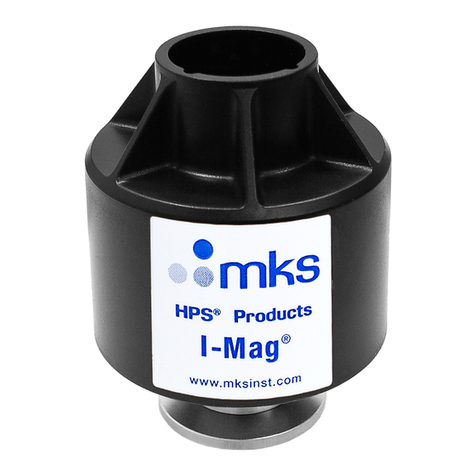MKS Ophir FPD-IG-25 User manual

Fasr Photodiode Detectors
Fast Photodiode Detectors
FPD-IG-25
Temporal Sensors
Temporal Sensors
User Manual
Ophir Optronics Solutions Ltd.

FPD-IG-25 User Manual 2
Ophir Fast Photodiode Detector User’s Manual
Thank you for purchasing your Fast Photodiode Detector from Ophir. This user’s manual will help answer any
questions you may have regarding the safe use and optimal operation of your Fast Photodiode Detector.
Table of Contents
I. Fast Photodiode Detector Overview................................................................................................................. 2
II. Operation of your Ophir Non-amplified High Speed Photodetector................................................................ 3
III. Batteries............................................................................................................................................................ 3
IV. Accessories....................................................................................................................................................... 4
V. Troubleshooting................................................................................................................................................ 4
VI. Specifications: Fast Photodiode Detectors....................................................................................................... 5
VII. Drawings: Fast Photodiode Detectors.............................................................................................................. 6
VIII. Schematic: Fast Photodiode Detectors............................................................................................................. 7
IX. Glossary of Terms ............................................................................................................................................ 7
I. Fast Photodiode Detector Overview
Ophir’s Fast Photodiode Detectors contain PIN photodiodes that utilize the photovoltaic effect to
convert optical power into an electrical current for measurement. Internal circuitry provides a
reverse bias voltage to improve the photodiode’s response time. For optimal performance, the
output should be connected to a 50Ω load resistance. Figure 1 below identifies the main elements
of your Fast Photodiode Detector.
Figure 1: Ophir Fast Photodiode Detector
When terminated into the 50Ω input of an oscilloscope, the pulse width of a laser can be measured.
When terminated into a spectrum analyzer, the frequency response of a laser can be measured

FPD-IG-25 User Manual 3
II. Operation of your Ophir Fast Photodiode Detector
A. Caution: Eye safety precautions must be followed with any equipment used in the vicinity of laser
beams. Laser beams may reflect from the surface of the detector or the optical mount and caution
must be exercised.
B. Mount the detector to an optical stand by the mounting holes on the bottom of the detector housing.
Each detector is provided with an 8-32 threaded nylon standoff. If the detector is mounted to a metal
post, it is recommended to insert the standoff between the detector and the post in order to minimize
the potential for electrical noise pickup.
C. Adjust the voltage scale of the oscilloscope to 20mV/division before connecting the detector.
D. Connect the detector to the oscilloscope using a coaxial cable designed for at least 15 GHz operation.
E. Use the 50Ω termination input of the oscilloscope.
F. After being certain that the damage threshold of the detector is not exceeded, place the detector in
the laser beam and turn the detector power switch to “On”.
G. There is an internal 50Ω resistor in the output stage of the detector circuit. This will reduce the
output current from the detector to 50% of the photodiode output current. For example, the output to
your equipment will be 450µA for a 1mW optical input at a wavelength at which the responsivity is
0.9A/W.
Note: This 50Ω resistor presents a constant load to the photodiode so anytime the detector
power switch is turned on, current will be drawn from the batteries to flow through the
photodiode. To prevent premature battery drainage, turn off the power switch whenever the
detector is not in use.
III.Batteries
Batteries will typically operate for several years, but operation with CW or high rep rate lasers can
drain the batteries much faster. Leaving the detector output connected to a load for long periods of
time can also drain the batteries. It is recommended to disconnect the output whenever the detector
will not be in use for long periods of time.
As the batteries become depleted, the bias voltage on the photodiode will decrease. This will
increase the rise and falls times of the detector and also reduce its saturation level. The ability of the
battery to supply current quickly will also be reduced which is manifested as saturation effects in the
output signal.
The batteries can be accessed for checking their voltage and replacement by removing the top plate
of the housing. If necessary, replace with type two (2) CR2430 lithium cells. Install batteries with
positive side down.

FPD-IG-25 User Manual 4
IV.Accessories
The following types of accessories are available for use with Ophir Fast Photodiode Detectors:
1. Fiber optic cable connectors
2. Adapters for attachment to IS6 integrating spheres
3. ND filters for attenuating the laser signal level
Fiber Adapters
SC type
7Z08227
ST type
7Z08226
FC type
7Z08229
SMA type
1G01236A
ND Attenuators
ND1 nom. X10 attenuator
7Z08200
ND2 nom. X50 attenuator
7Z08201
IS6 Integrating Sphere
Adapter
For FPD detectors
7Z08350
V. Troubleshooting
A. No signal is seen the first time the detector is used.
1. Is the power switch on?
2. Be certain that the signal is not too high for the scale set on the oscilloscope.
3. Is the wavelength of the laser within the spectral range of the detector?
4. Has a 50Ω termination input been used?
5. Try moving the detector within the laser beam. The detector’s small active area may make
alignment somewhat difficult.
6. Is the light level (see sensitivity spec on the data sheet) incident on the detector sufficient to
generate a measurable signal?
SC fiber adapter ST fiber adapter FC fiber adapter SMA fiber adapter
ND Attenuators IS6 Integrating
Sphere Adapter

FPD-IG-25 User Manual 5
B. A signal has been detected previously obtained, but is currently lost.
1. Try steps listed under A.
2. Inspect the active area of the photodiode for any signs of damage.
3. Test the batteries :
a. Units with internal batteries will typically operate for several years, but operation with CW
or high rep rate lasers can drain the batteries much faster.
The 50Ω output resistor presents a constant load to the photodiode so anytime the detector
power switch is turned on, current will be drawn from the batteries to flow through the
photodiode. To prevent premature battery drainage, turn off the power switch
whenever the detector is not in use.
Remove top cover to replace the 3V lithium cells with Duracell Model DL2430, positive side
down.
b. Units with an external power supply should at least receive the voltage that is printed on the
plug.
C. Increasing the power incident on the detector does not result in a higher voltage signal on the
oscilloscope:
1. The detector is probably saturated. You should lower the power incident on the
detector to a level below the saturation point.
VI. Specifications: Fast Photodiode Detectors
Model (a)
FPD-IG-25
Detector Type
InGaAs
Rise Time/Fall Time nsec
<0.025
Spectral Range nm (see graph below)
900-1700
Active Area Diameter mm
0.032
Detector Area mm2
0.00080
Wavelength of Peak Sensitivity nm
1500
Responsivity at Peak Wavelength A/W
0.95
Responsivity (Irradiance) at Peak Wavelength V/(W/cm2)
0.19 x 10-3
Bias Voltage VDC
6
Bias Voltage Source
Batteries
Battery Type
CR2430 x2
Bandwidth
>15 GHz
Dark Current nA
<3
Noise Equivalent Power(b) pW/√Hz
20
Maximum Average Power Input (b), (c) mW
10
Mounting (Tapped Holes)
8-32 & M4
Output Connector
SMA
Accessory Threads
M20x1
Version
Part Number
7Z02508
Notes: (a) All specs are with 50 load
Notes: (b) At wavelength of peak sensitivity
Notes: (c) Maximum peak power is twice the average power for 10 nsec pulses
This manual suits for next models
1
Table of contents
Other MKS Accessories manuals























